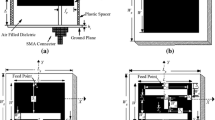Abstract
An inherent disadvantage of a Microstrip Patch Antenna (MPA) is its narrow bandwidth and low gain. There are various techniques in the market that either enhances gain or bandwidth of the MPA. The proposed system uses a novel technique which proves to enhance both the bandwidth, as well as the gain up to a great extent, simultaneously. We have tried to overcome these limitations by inserting slots in the proposed Rectangular Microstrip Patch Antenna (RMPA), also known as the slotted array technique. The proposed antenna has been designed for an operating frequency of 9 GHz which lies in the X-band of an electromagnetic system. It has been simulated over an RT Roger/duroid 5880 material that has a dielectric constant of 2.2, using HFSS software. It was observed that the RMPA has a bandwidth of 425.2 MHz, whereas, a bandwidth of 920 MHz has been achieved for slotted RMPA, that means 494.8 MHz of bandwidth enhancement. In addition to this, a gain of 6.92 dB has been achieved for RMPA, whereas, by introducing slots, the gain becomes 19.88 dB, i.e., an enhanced value of 12.96 dB has been achieved. This antenna can be used in various wireless applications such as: Wi-Fi, Bluetooth, and wireless LAN, and satellite and radar communication.








Similar content being viewed by others
References
Singh, I., & Tripathi, V. S. (2011). Microstrip patch antenna and its application: A survey. International Journal of Computer Technology and Applications, 2(5), 1595–1599.
Srivastava, H., Singh, A., Rajeev, A., & Tiwari, U. (2019). Comparison of different microstrip patch antennas with proposed RMPA for wireless applications. In 2019 International conference on power electronics, control and automation (ICPECA) (pp. 1–4). New Delhi, India.
Kaur, H., & Kaur, E. M. (2018). Design of microstrip patch circular antenna using microstrip line feed technique. International Journal for Research in Applied Science and Engineering Technology (IJRASET), 6(X), 1–8.
Garg, R., Bartia, P., Bahl, I., & Ittipiboon, A. (2001). Microstrip antenna design handbook (pp. 253–316). Norwood, MA: Artech House Inc.
Paul, L. C., Hosain, M. S., Sarker, S., Prio, M. H., Morshed, M., & Sarkar, A. K. (2015). The effect of changing substrate material and thickness on the performance of inset feed microstrip patch antenna. American Journal of Networks and Communications, 4(3), 54–58.
Guha, D., Chattopadhya, S., & Siddiqu, J. Y. (2010). Estimation of gain enhancement replacing PTFE by air substrate in a microstrip patch antenna [antenna designer’s notebook]. IEEE Antennas and Propagation Magazine, 52(3), 92–95.
Midasala, V., & Siddaiah, P. (2016). Microstrip patch antenna array design to improve better gains. Procedia Computer Science, 85, 401–409.
Saravanan, M., Beslin Geo, V., & Umarani, S. M. (2018). Gain enhancement of patch antenna integrated with metamaterial inspired superstrate. Journal of Electrical Systems and Information Technology, 5, 263–270.
Islam, M. T., Shakib, M. N., & Misran, N. (2009). Design analysis of high gain wideband L-probe fed microstrip patch antenna. Progress in Electromagnetics Research, 95, 397–407.
Chaimool, S., Chung, K. L., & Akkaraekthalin, P. (2010). Bandwidth and gain enhancement of microstrip patch antennas using reflective metasurface. IEICE Transactions, 93(B), 2496–2503.
Boutayeb, H., & Denidni, T. A. (2007). Gain enhancement of a microstrip patch antenna using a cylindrical electromagnetic crystal substrate. IEEE Transactions on Antennas and Propagation, 55(11), 3140–3145.
Lotfi-Neyestanak, A. A. (2008). Ultra wideband rose leaf microstrip patch antenna. Progress in Electromagnetics Research, 86, 155–168.
Ang, B.-K., & Chung, B.-K. (2007). A wideband E-shaped microstrip patch antenna for 5–6 GHz wireless communications. Progress in Electromagnetics Research, 75, 397–407.
Monavar, F. M., & Komjani, N. (2009). Bandwidth enhancement of microstrip patch antenna using jerusalem cross-shaped frequency selective surfaces by invasive weed optimization approach. Progress in Electromagnetics Research, 121, 103–120.
AbuTarboush, H. F., Al-Raweshidy, H. S., & Nilavalan, R. (2009). Bandwidth enhancement for microstrip patch antenna using stacked patch and slot. In 2009 IEEE international workshop on antenna technology (pp. 1–4). Santa Monica, CA.
Chung, K. L., & Chaimool, S. (2012). Broadside gain and bandwidth enhancement of microstrip patch antenna using a MNZ-metasurface. Microwave and Optical Technology Letters, 54, 529–532. https://doi.org/10.1002/mop.26574.
Reddy, M. H., Joany, R. M., Reddy, M. J., Sugadev, M., & Logashanmugam, E. (2017). Bandwidth enhancement of microstrip patch antenna using parasitic patch. In 2017 IEEE international conference on smart technologies and management for computing, communication, controls, energy and materials (ICSTM) (pp. 295–298). Chennai.
Marotkar, D. S., & Zade, P. (2016). Bandwidth enhancement of microstrip patch antenna using defected ground structure. In 2016 International conference on electrical, electronics, and optimization techniques (ICEEOT) (pp. 1712–1716). Chennai.
Fan, S. T., Yin, Y. Z., Lee, B., Hu, W., & Yang, X. (2012). Bandwidth enhancement of a printed slot antenna with a pair of parasitic patches. IEEE Antennas and Wireless Propagation Letters, 11, 1230–1233.
Feng, M., Zhang, J., & Wu, W. (2017). A compact microstrip patch antenna with bandwidth enhancement. In 2017 7th IEEE international symposium on microwave, antenna, propagation, and EMC technologies (MAPE) (pp. 68–70). Xi’an.
Ketkuntod, P., Hongnara, T., Thaiwirot, W., & Akkaraekthalin, P. (2017) Gain enhancement of microstrip patch antenna using I-shaped Mushroom-like EBG structure for WLAN application. In 2017 International symposium on antennas and propagation (ISAP) (pp. 1–2). Phuket.
Srivastava, H., & Tiwari, U. (2019). Design, simulation and analysis of rectangular and circular microstrip patch antenna for wireless applications. International Journal of Recent Technology and Engineering (IJRTE), 8(4), 2277–3878.
Funding
This research is not funded by any of the funding agencies.
Author information
Authors and Affiliations
Corresponding author
Ethics declarations
Conflict of interest
The authors declare that they have no conflict of interest.
Ethical Approval
This chapter does not contain any studies with human participants or animals performed by any of the authors.
Additional information
Publisher's Note
Springer Nature remains neutral with regard to jurisdictional claims in published maps and institutional affiliations.
Rights and permissions
About this article
Cite this article
Srivastava, H., Singh, A., Rajeev, A. et al. Bandwidth and Gain Enhancement of Rectangular Microstrip Patch Antenna (RMPA) Using Slotted Array Technique. Wireless Pers Commun 114, 699–709 (2020). https://doi.org/10.1007/s11277-020-07388-x
Published:
Issue Date:
DOI: https://doi.org/10.1007/s11277-020-07388-x




